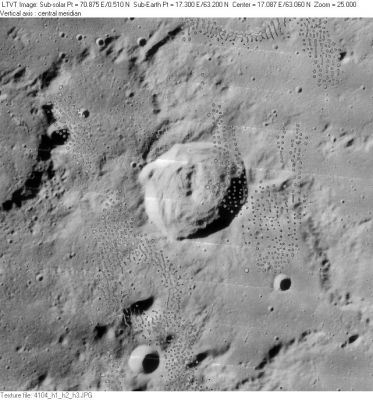Difference between revisions of "C. Mayer"
| Line 6: | Line 6: | ||
|} | |} | ||
<div id="toc"> | <div id="toc"> | ||
| − | + | [http://www.lpod.org/coppermine/albums/userpics/C-Mayer_LO-IV-104H_LTVT.JPG [[Image:normal_C-Mayer_LO-IV-104H_LTVT.JPG|external image normal_C-Mayer_LO-IV-104H_LTVT.JPG]]]<br /> ''[http://lpod.org/coppermine/displayimage.php?pos=-2473 LO-IV-104H]'' '''C. Mayer''' is in the center of this frame. 43-km '''C. Mayer H''' is to the northwest with identically-sized '''[[Archytas|Archytas]] D''' partially visible along the margin. The rectangular-appearing '''C. Mayer D''' (containing 7-km '''C. Mayer F''') is on the southwest. The circular crater at the bottom, below the two peaks, is '''C. Mayer E'''.<br /> <br /> | |
| − | |||
==Images== | ==Images== | ||
[http://www.lpod.org/coppermine/thumbnails.php?album=search&type=full&search=C.%20Mayer LPOD Photo Gallery] [http://www.lpi.usra.edu/resources/lunar_orbiter/bin/srch_nam.shtml?C.%20Mayer%7C0 Lunar Orbiter Images]<br /> <br /> | [http://www.lpod.org/coppermine/thumbnails.php?album=search&type=full&search=C.%20Mayer LPOD Photo Gallery] [http://www.lpi.usra.edu/resources/lunar_orbiter/bin/srch_nam.shtml?C.%20Mayer%7C0 Lunar Orbiter Images]<br /> <br /> | ||
| Line 25: | Line 24: | ||
* Cherrington, 1969: 1.79 km | * Cherrington, 1969: 1.79 km | ||
| − | * From the shadows in LO-IV-104H, the highest parts of the east wall are at least 2200 m above the floor. The southernmost of the central peaks rises about 480 m above its shadow tip. LO-IV-092H gives a lower sun angle view indicating the variation in the height of the east wall is from about 1880 to 2720 m, highest in the north. And the southern central peak is actually at least 710 m tall. <span class="membersnap">- | + | * From the shadows in LO-IV-104H, the highest parts of the east wall are at least 2200 m above the floor. The southernmost of the central peaks rises about 480 m above its shadow tip. LO-IV-092H gives a lower sun angle view indicating the variation in the height of the east wall is from about 1880 to 2720 m, highest in the north. And the southern central peak is actually at least 710 m tall. <span class="membersnap">- Jim Mosher</span> |
Central peak height<br /> | Central peak height<br /> | ||
| Line 43: | Line 42: | ||
<br /> | <br /> | ||
---- | ---- | ||
| − | + | </div> | |
Revision as of 16:16, 15 April 2018
Contents
C. Mayer
|
Lat: 63.2°N, Long: 17.3°E, Diam: 38 km, Depth: 1.12 km, Rükl: 5 |
LO-IV-104H C. Mayer is in the center of this frame. 43-km C. Mayer H is to the northwest with identically-sized Archytas D partially visible along the margin. The rectangular-appearing C. Mayer D (containing 7-km C. Mayer F) is on the southwest. The circular crater at the bottom, below the two peaks, is C. Mayer E.
Images
LPOD Photo Gallery Lunar Orbiter Images
Maps
(LAC zone 13A1) LAC map Geologic map
Description
Description: Elger
(IAU Directions) CHRISTIAN MAYER.--A prominent rhomboidal-shaped ring-plain, 18 miles in diameter, associated on every side, except the N., with a number of irregular inconspicuous enclosures. It has a central peak. Madler discovered two delicate short clefts, both running from N.E. to S.W., one on the E. and the other on the W. of this formation.
Description: Wikipedia
Additional Information
Depth data from Kurt Fisher database
- Pike, 1976: 1.12 km
- Westfall, 2000: 2.36 km
- Viscardy, 1985: 2.25 km
- Cherrington, 1969: 1.79 km
- From the shadows in LO-IV-104H, the highest parts of the east wall are at least 2200 m above the floor. The southernmost of the central peaks rises about 480 m above its shadow tip. LO-IV-092H gives a lower sun angle view indicating the variation in the height of the east wall is from about 1880 to 2720 m, highest in the north. And the southern central peak is actually at least 710 m tall. - Jim Mosher
Central peak height
- Sekiguchi, 1972: 0.6 km "Two-peaked ridge" - fatastronomer fatastronomer
Nomenclature
- Christian; German astronomer, mathematician, physicist (1719-1783).
- The secondary crater C.Mayer D was once known as Gasser. This name was one of Felix Chemla Lamech's new names, but was not accepted by the I.A.U.
- Research: Ewen A. Whitaker and Danny Caes (August 2003: mail correspondence).
LPOD Articles
Bibliography
- C.Mayer D ("Gasser"): Mapping and Naming the Moon; a history of lunar cartography and nomenclature (Ewen A. Whitaker).
